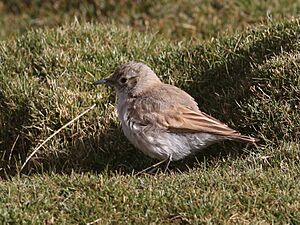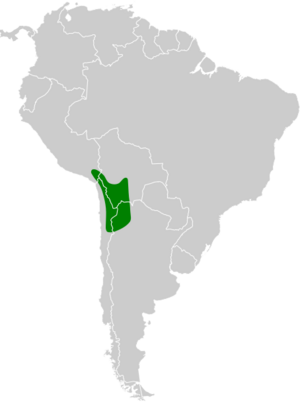Puna miner facts for kids
Quick facts for kids Puna miner |
|
|---|---|
 |
|
| Conservation status | |
| Scientific classification | |
| Genus: |
Geositta
|
| Species: |
punensis
|
 |
|
The puna miner (Geositta punensis) is a small bird that lives in the high mountains of South America. It belongs to the ovenbird family, known for their unique nests. You can find this bird in countries like Argentina, Bolivia, Chile, and Peru.
Contents
What the Puna Miner Looks Like
The puna miner is a medium-sized bird. It is about 13.5 to 14 centimeters (5.3 to 5.5 inches) long. It weighs between 22 and 29 grams (0.78 to 1.02 ounces). Both male and female puna miners look alike.
Its face is a pale grayish-brown. It has a light, buffy-white stripe above its eye, called a supercilium. From its head to its back, it is a pale sandy brown color. The feathers near its tail are even lighter.
Its tail feathers have pale reddish-brown bases. The middle parts are dark brownish or blackish. The tips are also pale reddish-brown. The outer tail feathers are almost entirely white on their outer edges.
The bird's wing feathers are dark brownish. They have whitish-buff tips. When the bird flies, you can see a band of pale reddish-brown near the bases of its flight feathers.
Its throat, chest, and belly are a light buff-white color. Its sides have a pale reddish tint. The puna miner has brown eyes. Its bill (beak) is medium-sized and blackish. The bottom part of its bill is blue-gray. Its legs and feet are dark gray.
Where the Puna Miner Lives
The puna miner lives in the Altiplano. This is a very high plateau in the Andes mountains. You can find it in southern Peru, western Bolivia, northeastern Chile, and northwestern Argentina.
It likes to live in high grasslands and open, barren areas. Sometimes, it can be found on open slopes above small ravines with bushes.
These birds usually live at elevations between 3,200 and 4,600 meters (10,500 to 15,100 feet) above sea level. They can sometimes be found as low as 3,050 meters (10,000 feet) or as high as 5,000 meters (16,400 feet).
Puna Miner Behavior
How Puna Miners Move
Puna miners stay in the same area all year round. They do not migrate.
What Puna Miners Eat
Puna miners search for food alone or in pairs. They hop along the ground and on small bushes to find their meals. They mostly eat small insects and other arthropods. They also eat seeds.
Puna Miner Reproduction and Life Cycle
Puna miners usually breed during the summer in the Southern Hemisphere. This is typically between October and January. Scientists believe that puna miners stay with the same partner for life.
They build their nests in burrows. These burrows are often made by small rodents called tuco-tucos (Ctenomys) in dry, sandy soil. A female puna miner usually lays two or three eggs.
Puna Miner Sounds
The puna miner often sings while flying. Its song is a long, high series of "veoo" notes. The sound starts high and then goes lower. The song also includes some faster, "chattier" notes. When it flies, its call is a sharp, rich "pzea" or "kvee."
Puna Miner Status
The IUCN (International Union for Conservation of Nature) has looked at the puna miner. They have listed it as a species of Least Concern. This means it is not currently in danger of disappearing.
The puna miner lives across a large area. Even though its exact population size is not known, experts believe it is stable. There are no immediate threats to this bird. It is considered uncommon in some places but fairly common in others.
The puna miner lives alongside humans in the heavily grazed Altiplano. It has likely done so for thousands of years.


